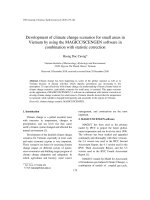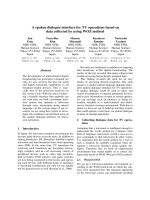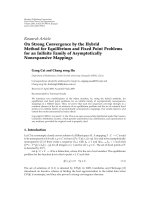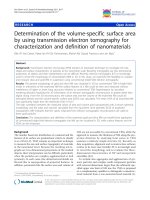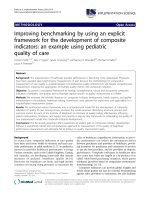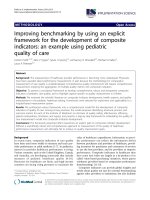Tracking trajectory by using the polynomial method for acc system based on smart car platform nguyen viet hung
Bạn đang xem bản rút gọn của tài liệu. Xem và tải ngay bản đầy đủ của tài liệu tại đây (2.84 MB, 5 trang )
2023 17th International Conference on Engineering of Modern Electric Systems (EMES) | 979-8-3503-1063-4/23/$31.00 ©2023 IEEE | DOI: 10.1109/EMES58375.2023.10171704
Tracking Trajectory by Using The Polynomial
Method for ACC System Based on Smart Car
Platform
Duc Lich Luu
Nguyen Viet Hung
Ciprian Lupu
Faculty of Transportation Mechanical
Engineering
University of Science and Technology
The University of Danang
Da Nang 550000, Vietnam.
Faculty of Information Technology
East Asia University of Technology
Bac Ninh, Viet Nam.
Department of Automatic Control
and Systems Engineering
University Politehnica of Bucharest
Bucharest, Romania.
Abstract—A well-known advanced driver assistance technology
that can be employed for that is the Adaptive Cruise Control
System (ACC). Cars equipped with ACC system are to control
the car speed to follow a driver’s set speed closely when there
is no leading car. When a slower leading car is present based
on distance sensor, the ACC controlled car are able to keep
desired distance with respect to the position and velocity of
the car in front. This paper presents a design methodology
of Adaptive Cruise Control (ACC) system for two smart car
platform consist of the leading smart car and a host smart car
move on a single lane on a laboratory installation. RST algorithm
in the multi algorithms structure is proposed to design in realtime architecture for ACC system. RST algorithm is one of the
most effective solutions for the real-time control of nonlinear
systems or working regimes. The results ofthe experiment have
been conducted to illustrate the effectiveness of the proposed
algorithm.
Keywords—RST controller, Adaptive cruise control, Automotive
electronics, Tracking trajectory, Real-time systems.
I. I NTRODUCTION
As travel demand has increased over the years, the expressway network has also been expanded to accommodate
the demand. To overcome these problems, the concept of the
Advanced Driver Assistant System is one of the approaches
which are under considerable research in the autonomous
vehicle technology. It ensure safety measures and comfort level
for drivers, passengers in urban areas [1] and improves the road
capacity [2]. This claim is possible due to the development
of mechatronics technology [3]. The car started to be driven
by hardware and software systems, creating the concept of
autonomous cars [4].
The ACC system is one of the subsystem of the Advanced
Driver Assistant System which is one application of keeping
small distance with the preceding vehicle. The ACC system
have two modes of steady state operation: velocity control and
vehicle following i.e. distance control based on the measured
signals of sensors [5], [6].
In autonomous robot area, the smart car platform has been
studied in recent years, some researchers of [7], [8] have
Fig. 1. Two smart cars following each other on a single lane
been proposed many robot in the platooning to applied for
the ACC system with different controllers including predictive
controller, sliding mode controller, controller and review into
account for the noise from hardware (devices and motors).
Some other papers [6], [9], [10], they have been made and
tested smart car platform to stay a formation same time
avoiding collisions, spotting people, fire or a tracking lane
system.
However, one of the main problems of employing these
algorithms is that the computation is large, complex and difficult to implement in a real-time application or in a discretetime system. To the best of our knowledge, there are very
few scientific works on multi algorithms structure consist of
RST algorithms applied to autonomous cars, especially ACC
systems. Some researchers have introduced the RST control
approach as in [9], [11], [12], [13].
In this paper, RST algorithm in the multi algorithms structure is proposed to design for ACC system. Digital Control Design by using the polynomial method such as RST algorithm
with two outstanding advantages such as: simplicity and realtime applicability. We focus on implementing digital control
design by the polynomial method in the discrete time system
for ACC system.
The leading car is controlled by the ACC system with
the reference of the closed-loop (CL) system is the desired
velocity, based on a RST controller.
979-8-3503-1063-4/23/$31.00 ©2023 IEEE
Authorized licensed use limited to: Soongsil University. Downloaded on July 12,2023 at 00:00:03 UTC from IEEE Xplore. Restrictions apply.
Fig. 2. RST algorithm for ACC system
The host car is controlled by the ACC system with the
reference of the CL system is the desired distance, based on
a RST controller, it is to follow the leading car at the desired
distance based on the constant spacing policy and the testing
results is to verify the performances of two smart car platform
consist of the leading smart car and a host smart car as in Fig.1.
This paper is structured as follows: In Section 2, we
first consider the mathematical modeling of cars. Then ACC
Control Structure for host car is presented in Section 3. The
Real-Time Implementation and Results will be described in
Section 4 and in Section 5, conclusions will close this paper.
II. M ATHEMATICAL MODELING OF CARS
For simplicity, the longitudinal dynamics of car assume be
described by the following differential equations [14], [15]:
= v(t)
p(t)
(1)
pă(t) = a(t)
...
p (t) + pă(t) = u(t)
Where, the position, velocity, acceleration in longitudinal
axis of the car at time instant t are indicated by p(t), v(t),
a(t), respectively. As a result, the longitudinal dynamics of
the car can be represented by:
H(s) =
P (s)
1
= 2
U (s)
s (ζs + 1)
(2)
III. ACC C ONTROL S TRUCTURE FOR LEADING CAR AND
HOST CAR
Two smart cars move on a single lane in as Fig.1. The
ACC system may also be consider as an autonomous control
system that is made to operate with good performances when
there is uncertainty in the system and in the environment
for a long time and must be able to compensate for system
failures without any outside interference. This is employing
radar sensors, an electronic control unit and an appropriate
software which is processing the sensor data and providing
the necessary output to track the car ahead in safe conditions.
The leading car is designed by the ACC system which is
to adjust the velocity of car, the desired for the CL system is
the velocity of car.
Utilizing the ACC system of host car is to keep the same
speed with the lead car while keeping the value of desired
distance with respect to leading car.
The transfer function (2) of the longitudinal dynamics used
for digital controller design, expressed by the irreducible
fraction:
A(z −1 )
(3)
H(z −1 ) =
B(z −1 )
Where, A(z −1 ), B(z −1 ) polynomials are:
mP
a =3
A(z −1 ) = 1 +
aj .z −j
j=1
= 1 + a1 z −1 + a2 z −2 + a3 z −3
mP
b =3
bj .z −j
B(z −1 ) =
j=1
= b0 + b1 z −1 + b2 z −2 + b3 z −3
Various techniques, such as the RST controller have been
applied in recent years. The acronym RST stands for (R)Regulation, (S)-Sensitivity , and (T)-Tracking control. It is
also linked to R(z −1 ), S(z −1 ), T (z −1 ) polynomials that are
employed in the two-degree of freedom controller structure
[11].
The RST control algorithm in multi algorithms structure
with a closed-loop system was used with the ACC system
structure (Fig.2):
R(z−1 ) T (z−1 )
y(k)
u(k) ≡
− S(z−1 ) S(z−1 )
yref (k)
(4)
−1
R(z )
T (z −1 )
≡−
y(k) +
yref (k)
S(z −1 )
S(z −1 )
yref (k) - trajectory or filtered set point, in which: dref (k) is
the desired distace defined by the constant spacing policy for
host car or vref (k) is the desired velocity set by the human for
leading car; u(k) - algorithm output, the desired acceleration
for host car (control signal).
dref (k) = l0 (k)(m)
(5)
y(k) - process output, in which: d(k) is actual distance for
host car or v(k) is velocity for leading car, L is the car length,
and it is defined as:
Authorized licensed use limited to: Soongsil University. Downloaded on July 12,2023 at 00:00:03 UTC from IEEE Xplore. Restrictions apply.
IV. R EAL -T IME I MPLEMENTATION AND R ESULTS
In the demonstrative section, a small laboratory installation
that is used by a real-time software application for two smart
car platform travelling single lane as in Fig.3 that allows
practical verification of the proposed theoretical elements is
presented. The cost of components of each electric car can be
seen in table.1
The smart car platform is described as in [15], consisting
of a leading car and a host car. The cars is moved with
the distance which is actually very small, so employing the
infrared device is measured the distance between the leading
car and the host car. The longitudinal velocity is measured
from encoder sensor mounted on the rear wheels.
RST Controller Parameters Calculation: the choice of the
RST controller parameters allows to solve as well the problem
of regulation as well as of tracking, and using a sampling
period of Ts = 0.1 second, the system constraints as in [16]
are −2.5(m/s2 ) ≤ u(k) ≤ 2.5(m/s2 ) and these polynomials
are given by:
Fig. 3. The smart car platform in the laboratory [15]
TABLE I
C OMPONENTS OF A ELECTRIC CAR [15]
Component
Qty
Electric Car Module
MEGA 2560 microcontroller
L9110S driver module
Distance Sensor
Lines Sensor
Speed Sensor
Battery
WeMos D1 Mini ESP8266
1
1
2
1
2
4
2
1
Unit price
(USD)
20
9.0
2.0
7.2
7.5
2.0
7.5
7.0
Total
Total price
(USD)
20
9.0
4.0
7.2
15.0
8.0
15.0
7.0
85.2
R(z −1 ) = 249.4258 − 387.5863z −1 + 148.0126z −2
T (z −1 ) = 9.8521
S(z −1 ) = 1 + 0.7841z −1 + 0.1404z −2
d(k) = plead (k) − phost (k) − L
−1
−1
(6)
−1
R(z ), T (z ) and S(z ) polynomials of the proposed
RST digital feedback controller, the corresponding parameters
are defined as below:
m
r =2
X
rj .z −j = r0 + r1 z −1 + r2 z −2
R(z −1 ) =
j=0
T (z −1 ) =
m
t =0
X
tj .z −j = t0 .
(7)
j=0
1
1
1
= m =2
=
−1 + s z −2
s
P
S(z −1 )
s
+
s
z
0
1
2
sj .z −j
j=0
ms , mr , and mt illustrate the respective polynomial degrees
as well as the memory dimension for the algorithm’s software
implementation. For example, if mr = 2, three memory places
should be saved for the process’s output: y(k), y(k −1), y(k −
2). The same method applies to u(k), respectively. To apply
ms = mr = mt = 2, the control law computation is as the
following:
1
u(k) = [T (z −1 )yref (k) − r0 y(k) − r1 y(k − 1)
s0
(8)
− r2 y(k − 2) − s1 u(k − 1) − s2 u(k − 2)]
and formula (8) gives the algorithm’s memory actualization
for the next iteration:
u(k − 1) = u(k), y(k − 1) = y(k),
yref (k − 1) = yref (k).
The constraint condition are considered as follows: umin ≤
u(k) ≤ umax where umin < 0 and umax > 0 are bounds of
control input.
This sector only focus for the host car using ACC system
based on the constant spacing policy which is a common type
of strategy that shows real-time applicability. RST algorithm
is embedded in two smart cars (leading car and host car as in
Fig.3), in which the leading car equipped with ACC system,
maintains at reference velocity as in Fig.4 and the host car
equipped with ACC system to keep the same speed with the
leading car as in Fig.4 while keeping the value of desired
distance with respect to leading car i.e,0.35m as in Fig.5.
Adaptive Cruise control for the host car, i.e following the
reference trajectory with the desired distance dref (k) at a
discrete time k. The constant spacing policy, the ACC system
maintains at a fixed constant between leading smart car and
host smart car in Fig.3), with the initial distance and the fixed
desired distance is set to l0 = 0.35m.
The lead car stays the velocity at 0.5m/s in during time interval [0, 38.0s], and then decelerates from 0.5m/s to 0.4cm/s
during interval [38.1s, 42.0s], and then stays the speed at
0.4m/s during interval [42.1s, 70.0s]. Their velocities, the
distances between leading smart car and host smart car are
indicated in Figs.4, 5 respectively. From these figures, the
signals resulted after testing can be observed that velocity
tracking operates well.
Clearly, the distance of the host smart car converges to the
desired value, i.e 0.35m.
The host car exist a little large distance at time at 0s (start)
and a little overshoot after that, mainly caused by a higher
starting voltage than the minimum working voltage.
From testing results, we observe that RST algorithm results
for host cars satisfied with the request for real-time implementation. The time delay has existed as the micro-controler
Authorized licensed use limited to: Soongsil University. Downloaded on July 12,2023 at 00:00:03 UTC from IEEE Xplore. Restrictions apply.
errors due to the influence of noise, disturbance, environment
from hardware devices. However, does not seriously affect
the results. In general, the accurate sensors will bring better
performance.
Next step in future, mathematical models of cars in the
continuous time system convert to discrete time system. ACC
systems using RST algorithm will be implemented and simulated, thereby comparing simulation and testing.
ACKNOWLEDGMENT
This paper was performed in the PRECIS Research Center,
Laboratory 10 - Advanced Control Systems for Real - Time
Applications. The authors would like to thank the support of
this institutions.
Fig. 4. The velocities of two mart car platform based on the constant spacing
policy
Fig. 5. Inter-car distance of the host smart car platform based on the constant
spacing policy
of cars calculate the control command for the motor driver;
the devices are affected by brightness, disturbance or noise
which leads to unstable measurement results. However, the
result error is not large. In general, an accurate sensor will
bring better performance to the smart car platform.
V. C ONCLUSIONS
In this paper, RST algorithm in the multi algorithms
structure for the ACC system was studied. The polynomial
method in the discrete time system for ACC system will
eliminate the need complex mathematical derivatives, model
uncertainties and linearization. In real-time applications, two
smart car platform equipped with the ACC system is tested and
implemented on a laboratory control structure, each smart car
platform based on sensors. Its purpose is to make the efficiency
of RST algorithm.
Testing results show the leading car maintains at reference
speed. and the host car to keep the same speed with the
leading car while keeping the desired distance with respect
to leading car. However, there was the time delay and some
R EFERENCES
[1] J. Guanetti, Y. Kim, and F. Borrelli, “Control of connected and automated vehicles: State of the art and future challenges,” Annual reviews
in control, vol. 45, pp. 18–40, 2018.
[2] M. Nagai, “The perspectives of research for enhancing active safety
based on advanced control technology,” Vehicle System Dynamics,
vol. 45, no. 5, pp. 413–431, 2007.
[3] K. Reif, Automotive Mechatronics Konrad Reif Ed. Springer Vieweg,
2019.
[4] H. Yu, X. Li, R. M. Murray, S. Ramesh, and C. J. Tomlin, Safe,
autonomous and intelligent vehicles. Springer, 2018.
[5] D. L. Luu and C. Lupu, “Dynamics model and design for adaptive cruise
control vehicles,” in 2019 22nd International Conference on Control
Systems and Computer Science (CSCS). IEEE, 2019, pp. 12–17.
[6] D. L. Luu, C. Lupu, I. Cristian et al., “Speed control and spacing control
for autonomous mobile robot platform equipped with infrared sensors,”
in 2021 16th international conference on engineering of modern electric
systems (EMES). IEEE, 2021, pp. 1–4.
[7] G. Guo and W. Yue, “Sampled-data cooperative adaptive cruise control
of vehicles with sensor failures,” IEEE Transactions on Intelligent
Transportation Systems, vol. 15, no. 6, pp. 2404–2418, 2014.
[8] M. Trudgen, R. Miller, and J. M. Velni, “Robust cooperative adaptive
cruise control design and implementation for connected vehicles,” International Journal of Automation and Control, vol. 12, no. 4, pp. 469–494,
2018.
[9] C. Lupu, C.-C. Mihai, F.-D. Secuianu, and C. Petrescu, “Fast disturbance
rejection in mimo process based on algorithms switching,” in 2018 22nd
International Conference on System Theory, Control and Computing
(ICSTCC). IEEE, 2018, pp. 469–473.
[10] D. L. Luu and C. Lupu, “Experimenta1evaluation of smart cars model
for a platoon of vehicles,” in 2019 23rd International Conference on
System Theory, Control and Computing (ICSTCC). IEEE, 2019, pp.
815–820.
[11] I. D. Landau and G. Zito, Digital control systems: design, identification
and implementation. Springer, 2006, vol. 130.
[12] C. Lupu, D. Popescu, and A. Udrea, “Real-time control applications for
nonlinear processes based on adaptive control and the static characteristic,” WSEAS Transactions on Systems and Control, vol. 3, no. 6, pp.
607–616, 2008.
[13] D. Popescu, A. Gharbi, D. Stefanoiu, and P. Borne, Process Control
Design for Industrial Applications. John Wiley & Sons, 2017.
[14] R. Rajamani, Vehicle dynamics and control. London: Springer Science
& Business Media, 2011.
[15] D. L. Luu, C. Lupu, and T. Van Nguyen, “Design and simulation
implementation for adaptive cruise control systems of vehicles,” in
2019 22nd International Conference on Control Systems and Computer
Science (CSCS). IEEE, 2019, pp. 1–6.
[16] D. L. Luu, H. T. Pham, C. Lupu, T. B. Nguyen, and S. T. Ha, “Research
on cooperative adaptive cruise control system for autonomous vehicles
based on distributed model predictive control,” in 2021 International
Conference on System Science and Engineering (ICSSE). IEEE, 2021,
pp. 13–18.
Authorized licensed use limited to: Soongsil University. Downloaded on July 12,2023 at 00:00:03 UTC from IEEE Xplore. Restrictions apply.
